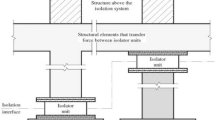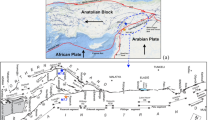Abstract
A parametric study is conducted to investigate the effect of lead rubber bearing (LRB) isolator and ground motion characteristics on the response of seismic isolated bridges. The purpose was to investigate the most favorable parameters of the LRB for minimum earthquake response of the isolated bridge system for different ground motions. The important parameters included are: ground motion characteristic by considering peak ground acceleration to peak ground velocity, PGA/PGV ratio as damage index; characteristic strength, Q d of the LRB isolator normalized by the weight acting on the isolator; flexibility of isolator by varying post yield time period, T d ; and yield stiffness to post yield stiffness, K u /K d ratio. The performance of seismic isolated bridge is measured by the variation of maximum isolator displacement (MID), maximum isolator force (MIF), deck acceleration and pier base shear. For a specified ground motion, smaller MID and MIF are regarded as indicator of better seismic performance. It is found that there exists a particular value of Q d /W, T d and K u /K d for which the MID, MIF, deck acceleration and pier base shear attain the minimum values. Finally the recommendations are made which are useful for the design engineers at the preliminary seismic isolation design of the bridges with LRB isolator for the ground motion having different characteristics.
Similar content being viewed by others
References
AASHTO (1999). Guide Specifications for sEismic Isolation Design, Washington DC: American Association of State Highway Officials.
ASCE (1998). Evaluation Findings for Skellerup Base Isolation Elastomeric Bearings, Technical Evaluation Report, (CERF Report: HITEC 98-12), prepared by the Highway Innovative Technology Evaluation Center.
Ali, H.M. and Abdel-Ghaffar, A.M. (1995), “Modeling of rubber and lead passive-control bearings for seismic analysis.” Journal of Structural Engineering, Vol. 121, No. 7, pp. 1134–1144.
Buckle, I.G. and Mayes, R.L. (1990). “Seismic isolation: history, application and performance — A world overview.” Earthquake Spectra, Vol. 6, pp. 161–202.
Chopra, A.K. (2001). “Dynamics of Structures: Theory and Applications to Earthquake Engineering.” Wiley: New Jersey, U.S.A. pp. 288–295.
Dicleli, M. and Bruneau, M. (1995). “An energy approach to sliding of single-span simply supported slab-on-girder steel highway bridges with damaged bearings.” Earthquake Engineering and Structural Dynamics, Vol. 24, No. 3, pp. 395–409.
Fragiacomo, M., Rajgelj, S., and Cimadom, F. (2003). “Design of bilinear hysteretic isolation systems.” Earthquake Engineering and Structural Dynamics, Vol. 32, No. 9, pp. 1333–1352.
Heidebrecht, A.C. and Lu, C.Y. (1988). “Evaluation of the seismic response factor introduced in the 1985 edition of the national building code of Canada.” Canadian Journal of Civil Engineering, Vol. 15, pp. 382–338.
Jangid, R.S. (2006). “Optimum lead-rubber bearings for near-fault motions.” Engineering Structures, Vol. 29, No. 10, pp. 2503–2513.
Jerome, J. C. (2002). Introduction to Structural Motion Control, Massachusetts Institute of Technology, Pearson Education, Inc., Upper Saddle River, New Jersey 07458.
Kelly, J.M. (1986). “Asesmic base isolation: A review and bibliography.” Soil Dynamics and Earthquake Engineering, Vol. 5, pp. 202–216.
Kelly, J.M. and Hodder, S.B. (1982). “Experimental study of lead and elastomeric dampers for base isolation system in laminated neoprene bearings.” Bulletin of New Zealand National Society for Earthquake Engineering, Vol. 15, pp. 53–67.
Kunde, M.C. and Jangid, R.S. (2003). “Seismic behavior of isolated bridges: A state-of-the-art review.” Electronic Journal of Structural Engineering, Australia, Vol. 3, pp. 140–170.
Naeim, F. and Kelly, J. M. (1999). Design of Seismic Isolated Structures: From Theory to Practice, Wiley, Chichester, England.
Nove, N. (2007). “Representative ensembles of strong earthquake records.” The Canadian Association for Earthquake Engineering University of Ottawa, Ottawa, Ontario.
Oh, S. T. and Kim, Y. S. (1998). “Experimental and analytical investigation of a seismically isolated bridge model with friction pendulum system.” KSCE Journal of Civil Engineering, Vol. 2, No. 3, pp. 265–272.
Park, J. and Otsuka, H. (1999). “Optimal yield level of bilinear seismic isolation devices.” Earthquake Engineering and Structural Dynamics, Vol. 28, pp. 941–955.
Park, K.S., Jung, H.J., and Lee, I.W. (2002) “A comparative study on aseismic performances of base isolation systems for multi-span continuous bridge.” Engineering Structures, Vol. 24, No. 8, pp. 1001–1013.
Skinner, R. I., Robinson, W. H., and McVerry, G. H. (1993). An Introduction to Seismic Isolation, Wiley, Chichester, England.
Warn, C.P. and Whittaker, A.S. (2004). “Performance estimates in seismically isolated bridge structures.” Engineering Structures, Vol. 26, No. 9, pp. 1261–1278.
Zhou, F.L., Kelly, J.M., Fuller, K.N.G., and Pan, T.C. (1992). “Optimal design of seismic isolation for multistoried buildings.” Proceedings of the World Conference on Earthquake Engineering, Madrid, Spain.
Zhu, T.J., Tso, W.K., and Heidebrecht, A.C. (1988). “Effect of peak ground A/V ratio on structural damage.” Journal of Structural Engineering, Vol. 114, pp. 1019–1037.
Author information
Authors and Affiliations
Corresponding author
Rights and permissions
About this article
Cite this article
Hameed, A., Koo, MS., Do, T.D. et al. Effect of lead rubber bearing characteristics on the response of seismic-isolated bridges. KSCE J Civ Eng 12, 187–196 (2008). https://doi.org/10.1007/s12205-008-0187-9
Received:
Accepted:
Published:
Issue Date:
DOI: https://doi.org/10.1007/s12205-008-0187-9




